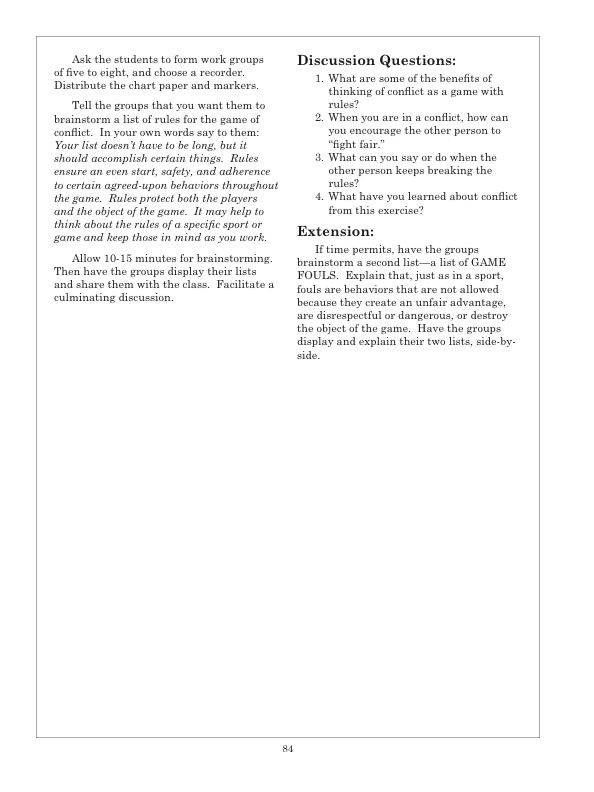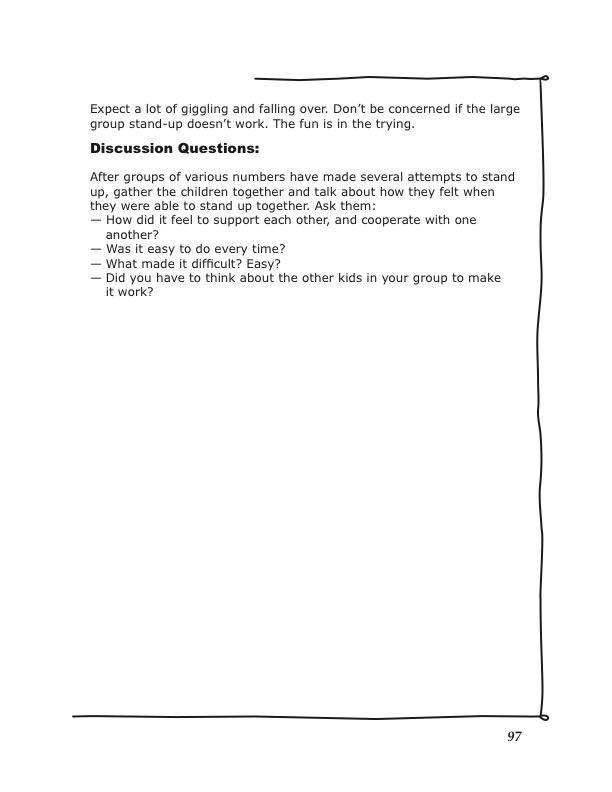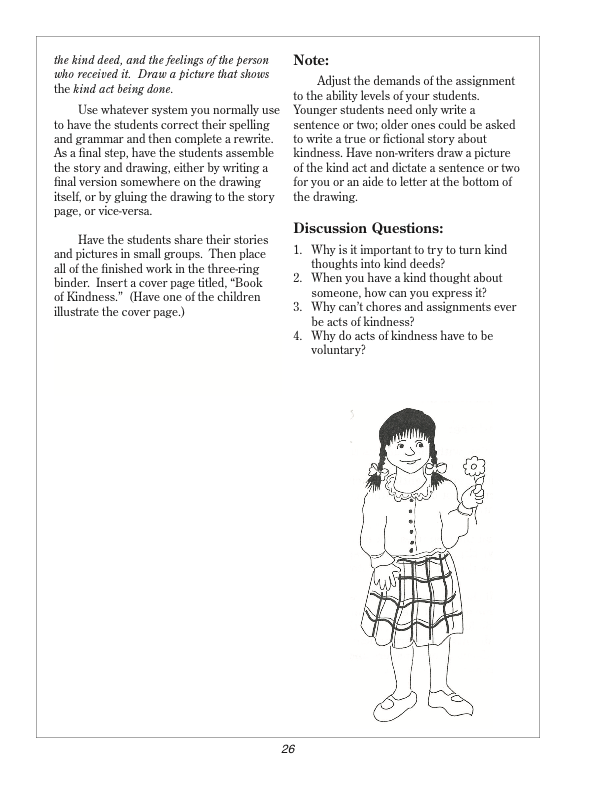As small children begin to organize their worlds and translate thoughts into meaningful sentences understood by others, a sense of accomplishment develops. They realize that through language, much information can be gained about the world, and others can be influenced to respond to their needs. They also learn that language is a key to friendship.
The development of language in small children can be supported most effectively by educators and parents when they frequently converse with the children and encourage them to hold conversations with each other. These verbal experiences strengthen not only the development of language, but also thought, which contributes to the child’s ability to be more self-controlling. It is important to use concrete terms and normal inflection and pronunciation as in adult-to-adult conversation when talking to small children. They should never be “talked down” to.
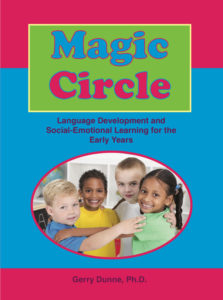
How You Can Facilitate This Learning
Today’s Blog activity comes from our book, Magic Circle: Language Development and Social-Emotional Learning for the Early Years. The process we call a Sharing Circle with older students, elementary through high school, is referred to as a Magic Circle with pre-schoolers and kindergarten students. As with Sharing Circles, Magic Circles are carefully structured safe social environments wherein young children can perform tasks, express themselves verbally, and receive positive acknowledgement for these actions and expressions.
Oral language is the principle mode of expression of Magic Circles. By speaking to their fellow circle members (peers and leader) and by listening to what others have to say, children’s growing abilities to verbally communicate are utilized and strengthened. Verbal expression is then built upon to inspire other forms of expression including art, reading, singing and drama.
Here is a Magic Circle Task entitled I Can Draw a Picture of Myself and Tell You About It for you to use with your children.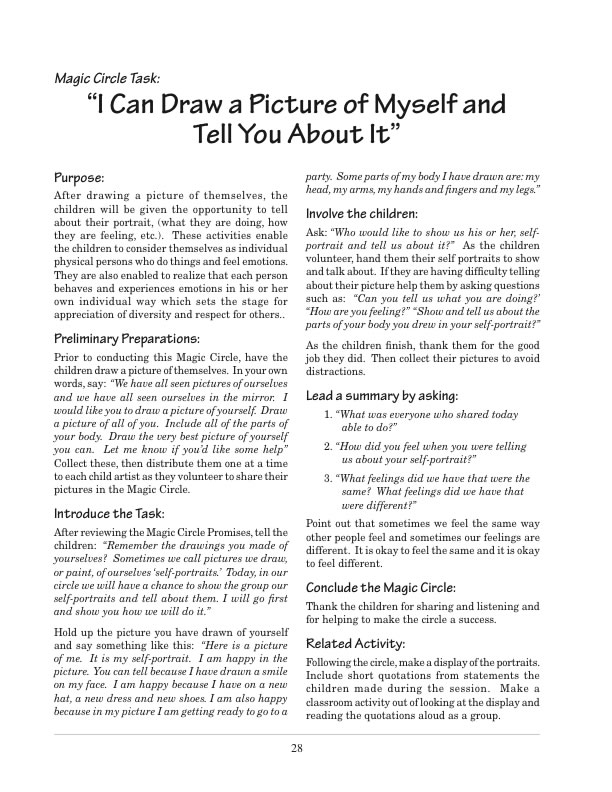
The Magic Circle has the same rules and structure as the Sharing Circle. If you want more information?
• Leading a Sharing Circle
• Sharing Circle Rules
• Books and Resources
• Free Activities
• Subscribe
Go here:
Here’s How It’s Done
Gather everyone into a circle. Explain the rules for sharing, and get agreement from everyone that they will follow the rules.
Magic Circle Rules:
- Everyone gets a turn to share, including the leader.
- You can skip your turn if you wish.
- Listen to the person who is sharing.
- There are no interruptions, probing, put-downs, or gossip.
- Share the time equally.
After everyone has shared, who wants to share, ask the discussion questions.
You can check the book out HERE.
Just click HERE to open a fully reproducible PDF of this activity and experience sheet…
If you like our blog resources and would like to receive them regularly, please subscribe here or on our website at www.InnerchoicePublishing.com
If you are already a subscriber, I hope you find this activity valuable. Help us grow our blog by sharing these activities and encouraging others to join. Thank you.
Thanks so much for reading!
Susanna
[New Post] An Activity for Developing Self Awareness
Through self-awareness, students learn to give ongoing attention to their internal states, to know what they are feeling when they are feeling it, to identify the events that precipitate upsets and emotional hijackings, and to bring their feelings back under control.
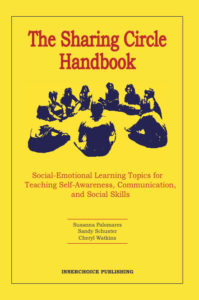
Self-awareness allows students to manage their feelings and to recover from bad moods more quickly. Students who are self-aware don’t hide things from themselves. Labeling feelings makes them their own. They can talk about fear, frustration, excitement, and envy and they can understand and speculate concerning such feelings in others, too.
Lacking self-awareness, students may become engulfed by their feelings, lost in them, overwhelmed by them. Unawareness of what is going on in their inner and outer worlds sets the stage for lack of congruence between what they believe or feel and how they behave. Feelings of isolation (“I’m the only one who feels this way.”) occur when students are unaware that others experience the same range of feelings that they do. Without self-awareness students never gain control over their lives. By default, their courses are plotted by others or by parts of themselves which they fail to recognize.
Self-awareness can take the form of nonjudgmental observation (“I’m feeling irritated.”) or it can be accompanied by evaluative thoughts (“I shouldn’t feel this way” or “Don’t think about that.”) Although, in and of themselves, emotions are neither right nor wrong, good nor bad, these kinds of judgments are common and indicate that the neocortical circuits are monitoring the emotion. However, to try to abolish a feeling or attempt to take away a feeling in someone else only drives the emotion out of awareness, where its activity along neural pathways continues unmonitored and unabated — as neuroses, insomnia, and communication failures of all kinds testify.
Your Sharing Circle
Here’s a Sharing Circle for you that will let your students explore one aspect of self-awareness that they have experienced, and will continue to experience from time to time throughout their lives. It comes from The Sharing Circle Handbook, Topics for Teaching Self-Awareness, Communication, and Social Skills for students in grades K-12. The topic is, How Somebody Hurt My Feelings.
 Here’s Your Monday Morning Sharing Circle. Enjoy!
Here’s Your Monday Morning Sharing Circle. Enjoy!
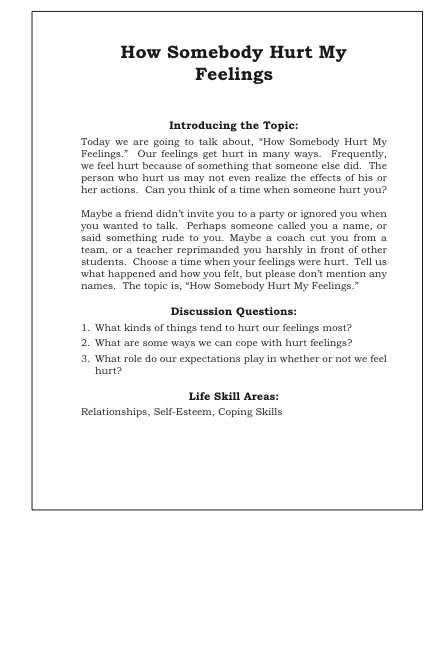
Do you want more information?
• Leading a Sharing Circle
• Sharing Circle Rules
• Books and Resources
• Free Activities
• Subscribe
Go here:
Here’s How It’s Done
Gather everyone into a circle. Explain the rules for sharing, and get agreement from everyone that they will follow the rules.
Sharing Circle Rules:
- Everyone gets a turn to share, including the leader.
- You can skip your turn if you wish.
- Listen to the person who is sharing.
- There are no interruptions, probing, put-downs, or gossip.
- Share the time equally.
After everyone has shared, who wants to share, ask the discussion questions.
You can check the book out HERE.
Just click HERE to open a fully reproducible PDF of this activity and experience sheet…
If you like our blog resources and would like to receive them regularly, please subscribe here or on our website at www.InnerchoicePublishing.com
If you are already a subscriber, I hope you find this activity valuable. Help us grow our blog by sharing these activities and encouraging others to join. Thank you.
Thanks so much for reading!
Susanna
NEW POST – Rules for A Fair Fight
Conflict, violence, and bullying are escalating in schools nationwide. Educators today express unprecedented concern about school and classroom disruptions that steal instructional hours and endanger the safety of students.
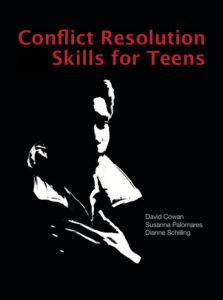
Some amount of conflict occurs normally in all schools. However, schools that are large, have limited resources, or serve highly diverse populations often experience pervasive conflict. Outside the school, a corresponding escalation in aggressive and violent behaviors exists in society at large. Our culture inadvertently supports violence through advertising, social relationships, politics, the media, and entertainment.
Keeping the Lid On Conflict
Often, conflicts escalate because students and the adults around them don’t know how to respond to disagreements and confrontations pro-socially and creatively. Peers — sometimes even parents —reward aggressive responses to conflict. These responses are modeled on television and in movies, where even the “good guys” maim and kill in order to “win.” Obviously, our society and our schools are in critical need of people with effective pro-social conflict resolution skills.
This week’s lesson focuses on how to bring a more positive , pro-social aspect to conflict.It has been taken from Conflict Resolution Skills for Teens, a learning guide for middle and high school.
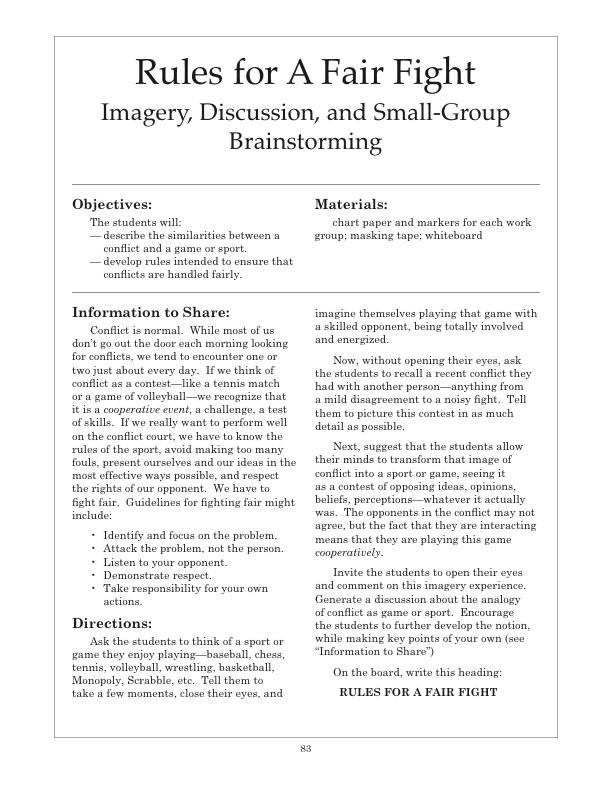
You can check the book out HERE.
Just click HERE to open a fully reproducible PDF of this activity and experience sheet…
If you like our blog resources and would like to receive them regularly, please subscribe here or on our website at www.InnerchoicePublishing.com
If you are already a subscriber, I hope you find this activity valuable. Help us grow our blog by sharing these activities and encouraging others to join. Thank you.
Thanks so much for reading!
Susanna
NEW BLOG – More on Cooperation
Having looked at cooperation and support as qualities of friendship in our last blog, let’s take a deeper look at cooperation and its impact on kids learning to work together.
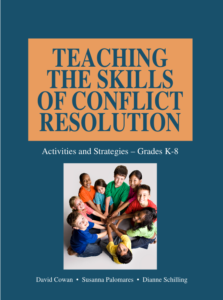
In A Perfect World
Ideally, cooperation is characterized by interdependence and inclusion. Everyone is valued for his or her uniqueness. They trust one another, turn to each other for help and advice and, when they experience conflict, utilize positive methods to resolve it. This Sharing Circle promotes cooperation and team building, children acquire many of the insights and skills necessary to interact effectively with their peers, to handle conflict, and to participate productively in collaborative projects and school assignments.
Your Sharing Circle
This Sharing Circle comes from Teaching The Skills of Conflict Resolution, our resource guide of activities and strategies for kids in grades K-8. The topic is, We Cooperated to Get It Done.
 Here’s Your Monday Morning Sharing Circle. Enjoy!
Here’s Your Monday Morning Sharing Circle. Enjoy!
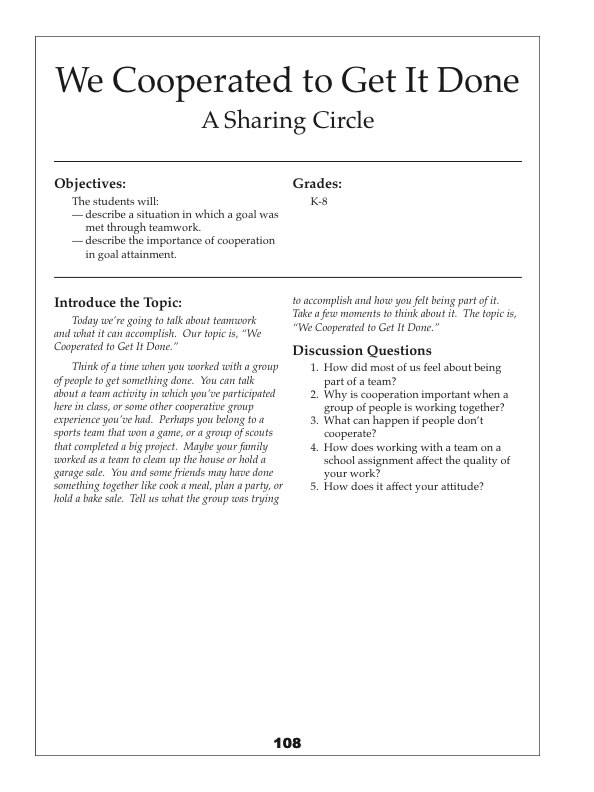
Do you want more information?
• Leading a Sharing Circle
• Sharing Circle Rules
• Books and Resources
• Free Activities
• Subscribe
Go here:
Here’s How It’s Done
Gather everyone into a circle. Explain the rules for sharing, and get agreement from everyone that they will follow the rules.
Sharing Circle Rules:
- Everyone gets a turn to share, including the leader.
- You can skip your turn if you wish.
- Listen to the person who is sharing.
- There are no interruptions, probing, put-downs, or gossip.
- Share the time equally.
After everyone has shared, who wants to share, ask the discussion questions.
You can check the book out HERE.
Just click HERE to open a fully reproducible PDF of this activity and experience sheet…
If you like our blog resources and would like to receive them regularly, please subscribe here or on our website at www.InnerchoicePublishing.com
If you are already a subscriber, I hope you find this activity valuable. Help us grow our blog by sharing these activities and encouraging others to join. Thank you.
Thanks so much for reading!
Susanna
A Quality of Friendship
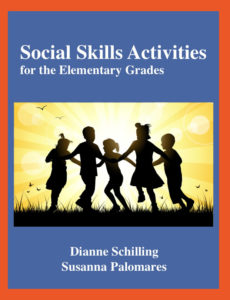
In keeping with our last blog here’s another activity to expand children’s repertoire of friendship skills. Being able to cooperate and give support to our friends conveys how we feel toward and are going to behave with our friends. This is one of the things we DO for and with our friends.
What Friends Do
Once again this week’s activity, Friends Support Each Other, is a cooperative game that comes from our book, Social Skills Activities for the Elementary Grades. Enjoy!
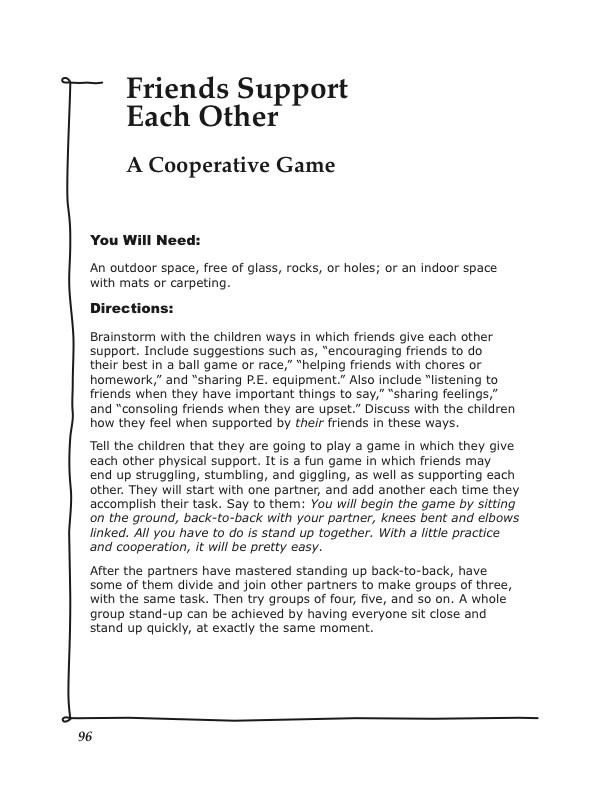
You can check the book out HERE.
Just click HERE to open a fully reproducible PDF of this activity and experience sheet…
If you like our blog resources and would like to receive them regularly, please subscribe here or on our website at www.InnerchoicePublishing.com
If you are already a subscriber, I hope you find this activity valuable. Help us grow our blog by sharing these activities and encouraging others to join. Thank you.
Thanks so much for reading!
Susanna
Helping Kids Make Friends
Cooperation, support, and having fun together are some of the things we experience with our friends. Our network of friends is one of the most important areas in which we develop social awareness. Children learn skills for interacting with others through successful interaction with their peer group. And having friends to care for and rely on can help them cope effectively with life’s daily challenges.

This week’s Sharing Circle and next week’s group activity both teach friendship skills and are designed to help students develop the ability to establish and maintain friendships.
Your Resources
Both this Sharing Circle and next week’s activity are taken from our book, Social Skills Activities for the Elementary Grades. Enjoy! The topic is, Something I Do to Keep a Friend.
 Here’s Your Monday Morning Sharing Circle. Enjoy!
Here’s Your Monday Morning Sharing Circle. Enjoy!
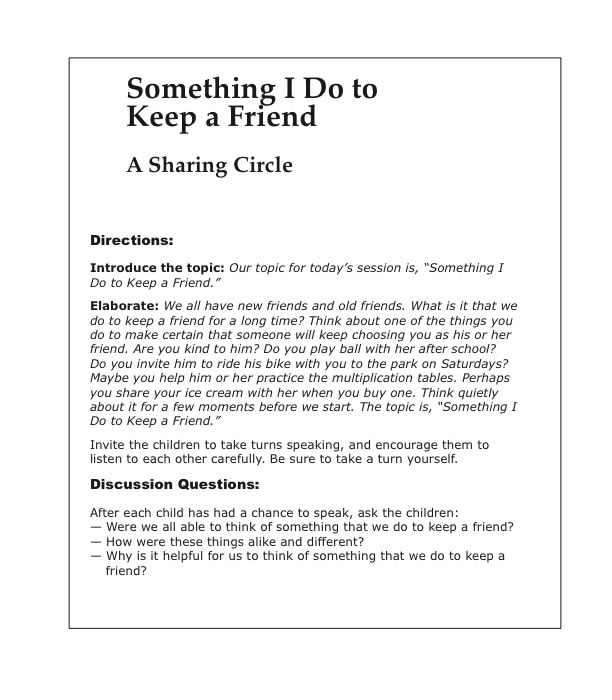
Do you want more information? • Leading a Sharing Circle • Sharing Circle Rules • Books and Resources • Free Activities • Subscribe
Here’s How It’s Done
Gather everyone into a circle. Explain the rules for sharing, and get agreement from everyone that they will follow the rules.
Sharing Circle Rules:
- Everyone gets a turn to share, including the leader.
- You can skip your turn if you wish.
- Listen to the person who is sharing.
- There are no interruptions, probing, put-downs, or gossip.
- Share the time equally.
After everyone has shared, who wants to share, ask the discussion questions.
You can check the book out HERE.
Just click HERE to open a fully reproducible PDF of this activity and experience sheet…
If you like our blog resources and would like to receive them regularly, please subscribe here or on our website at www.InnerchoicePublishing.com
If you are already a subscriber, I hope you find this activity valuable. Help us grow our blog by sharing these activities and encouraging others to join. Thank you.
Thanks so much for reading!
Susanna
Active Listening Skills for Managing Anger
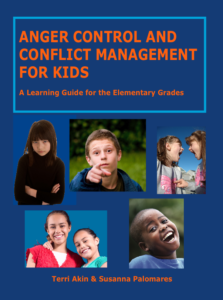
Active listening is a wonderful process for helping your students work through upsets to discover exactly what their feelings are.
When we listen actively to our students, two things happen at once. First, negative feelings lessen or disappear after they are expressed and acknowledged in a supportive, nonjudgmental manner, and second, we are modeling and thus teaching students the skill itself.
Active listening helps develop problem-solving skills. As you model and teach active listening, your students begin acquiring the skill, and they become increasingly able to talk through or articulate a problem clearly as opposed to having it just spinning in their heads because they are unable to express it. Through discussion, they are better able to work toward a solution. Active listening also facilitates the growth of a student’s ability to express himself or herself effectively.
A Tool for Today
Today’s lesson teaches the skills of Active Listening and applies them directly to lessening anger. It has been taken from Anger Control And Conflict Management, a learning guide for the elementary grades.
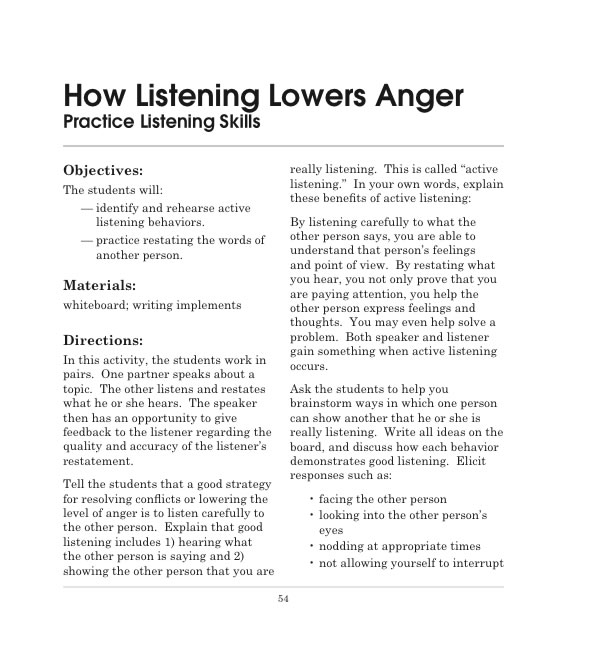
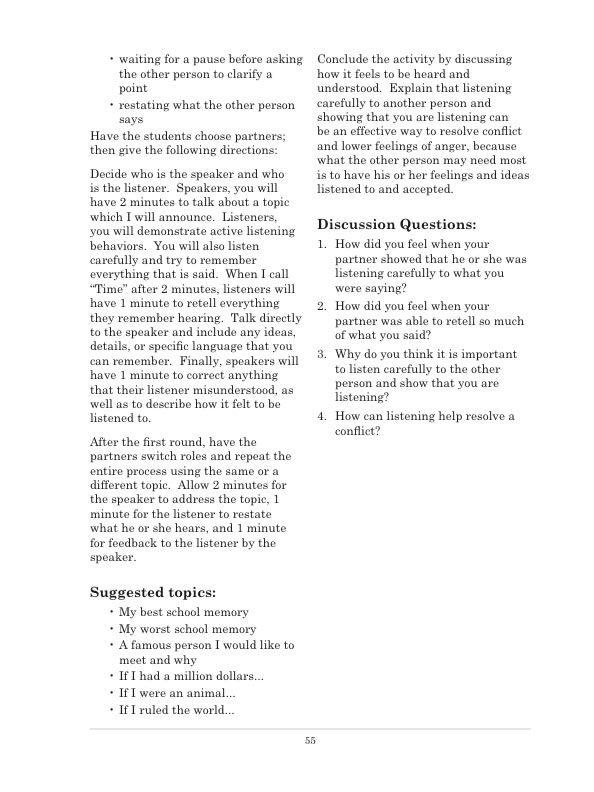
You can check the book out HERE.
Just click HERE to open a fully reproducible PDF of this activity and experience sheet…
If you like our blog resources and would like to receive them regularly, please subscribe here or on our website at www.InnerchoicePublishing.com
If you are already a subscriber, I hope you find this activity valuable. Help us grow our blog by sharing these activities and encouraging others to join. Thank you.
Thanks so much for reading!
Susanna
Helping Students Manage Negative Thinking
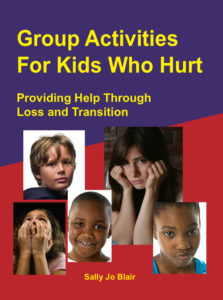
Students are often confronted with situations in their lives that produce hurt, anger, fear, grief, anxiety, and confusion.
Here Is A Great Resource for You
Here’s an activity that is an effective group counseling session as well as a solid classroom experience designed to harness the power of eclectic grouping by bringing students together, not only to be heard, but also to provide a support system for each other in the midst of their own hurting and healing. It is based on the premise that acknowledging hurt is one critical step in the process of healing. Developing compassion, forgiveness and moving beyond pain are other critical steps that can be facilitated in the context of group dynamics.
In this activity we are helping the students discover the power of thought and how it can help in their healing process.
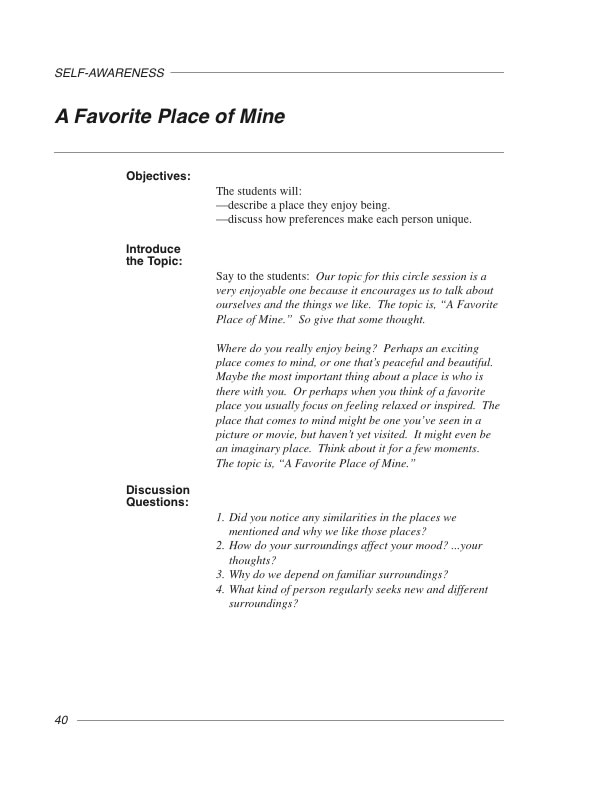
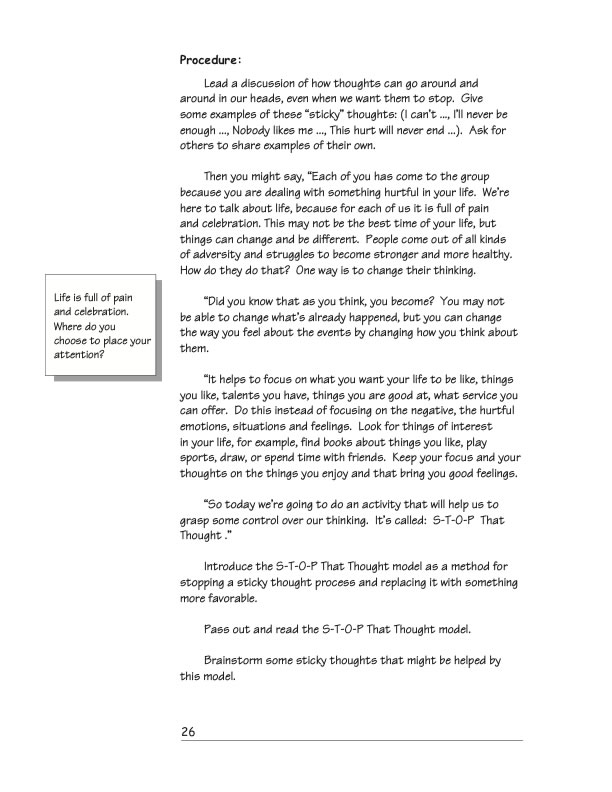
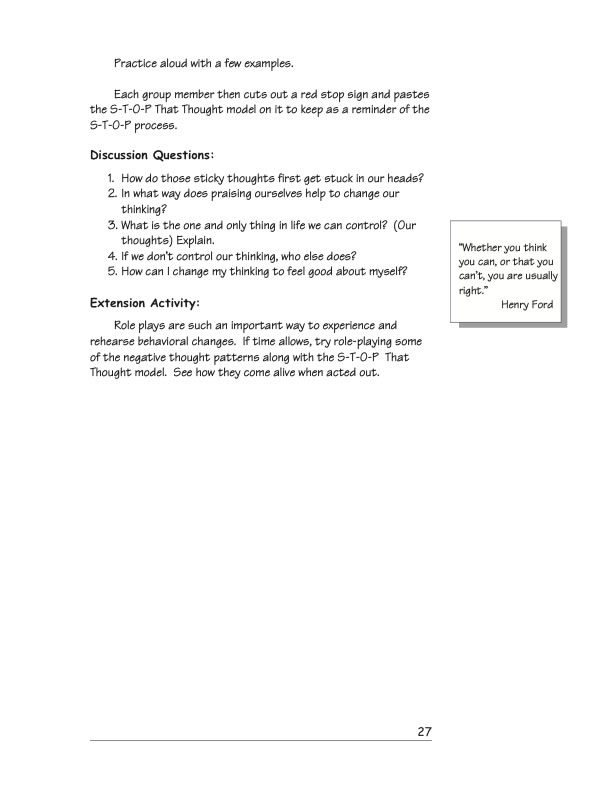
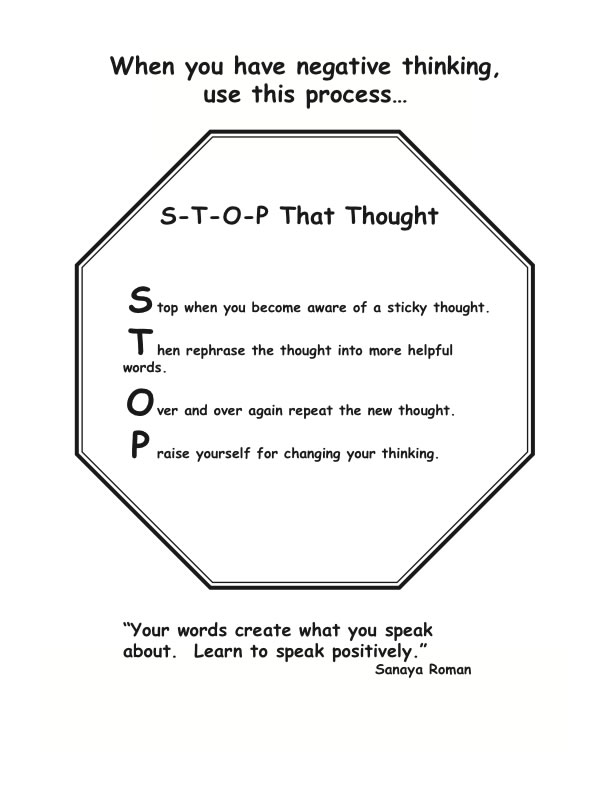
You can check the book out HERE.
Just click HERE to open a fully reproducible PDF of this activity and experience sheet…
If you like our blog resources and would like to receive them regularly, please subscribe here or on our website at www.InnerchoicePublishing.com
If you are already a subscriber, I hope you find this activity valuable. Help us grow our blog by sharing these activities and encouraging others to join. Thank you.
Thanks so much for reading!
Susanna
Awareness of Self and Others
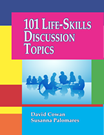
Awareness is a critical element in life-skill development. Aware people do not hide things from themselves. They are in touch with the inner world of their feelings and thoughts, and they are in control of their actions—and they understand that other people feel, think, and behave too. They are also in touch with the reality of the past, the possibilities of the future, and the certainty of the present. Awareness allows individuals to order their lives flexibly and effectively on a moment-to-moment basis. Awareness also allows us to connect with others and is fundamental to developing empathy.
Here’s a Sharing Circle That Focuses on the Nature of Awareness
This Sharing Circle topic comes from the activity book (Grades 4-12), 101 Life-Skills Discussion Topics. The topic is, A Favorite Place of Mine.
 Here’s Your Monday Morning Sharing Circle. Enjoy!
Here’s Your Monday Morning Sharing Circle. Enjoy!
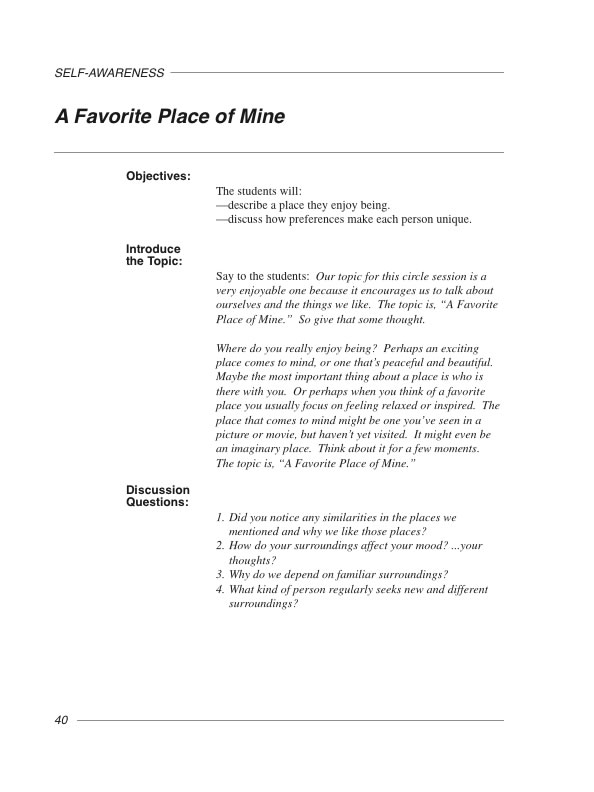
Do you want more information? • Leading a Sharing Circle • Sharing Circle Rules • Books and Resources • Free Activities • Subscribe
Here’s How It’s Done
Gather everyone into a circle. Explain the rules for sharing, and get agreement from everyone that they will follow the rules.
Sharing Circle Rules:
- Everyone gets a turn to share, including the leader.
- You can skip your turn if you wish.
- Listen to the person who is sharing.
- There are no interruptions, probing, put-downs, or gossip.
- Share the time equally.
After everyone has shared, who wants to share, ask the discussion questions. Get more in-depth information here.
Just click HERE to open a fully reproducible PDF of this Sharing Circle activity…
If you like our blog resources and would like to receive them regularly, please subscribe above or on our website at www.InnerchoicePublishing.com
If you are already a subscriber, I hope you find this activity valuable. Help us grow our blog by sharing these activities and encouraging others to join.
Thank you. Thanks so much for reading!
Susanna
Teaching Kindness
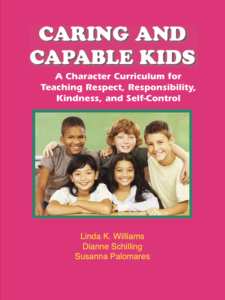
Today’s blog was inspired when I was sharing a meal the other day with a teacher friend. I asked how the new school year was starting out, and she shared that a challenge was getting the students to be kind to one another. I thought that providing a kindness activity today seemed the perfect response.
Kindness and Its Importance
Everyone intuitively knows the value of being kind, and teaching kindness and empathy to children. Observing or participating in acts of kindness sets a positive and caring tone for the day as well as reinforces important social-emotional skills. Modeling and reinforcing kindness makes it a practical and commonplace skill.
Many benefits have been reported in support of directly teaching kindness in schools including: Happy caring children; Greater sense of belonging and improved self-esteem; Improved health and less stress; increased feelings of gratitude; Better concentration; Reduced depression; Less bullying. In a 2016 report the US Department of Education said that research demonstrates the importance of kindness: “Students learn best when they feel safe, supported, challenged and accepted”. These are all elements of kindess.
Here’s Your Kindness Resource
This week’s activity helps students learn about the richness found in kind acts and behaviors and how they can be a benefit to all aspects of their lives. The activity, A Book of Kindness, comes from the resource guide, Caring and Capable Kids.
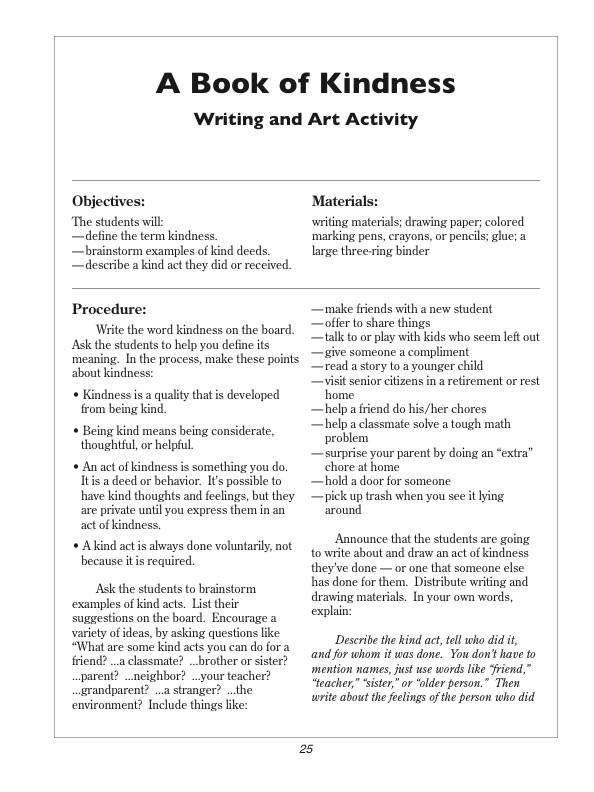
You can check the book out HERE.
Just click HERE to open a fully reproducible PDF of this activity and experience sheet…
If you like our blog resources and would like to receive them regularly, please subscribe here or on our website at www.InnerchoicePublishing.com
If you are already a subscriber, I hope you find this activity valuable. Help us grow our blog by sharing these activities and encouraging others to join. Thank you.
Thanks so much for reading!
Susanna

